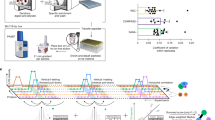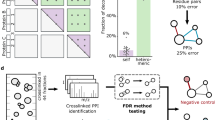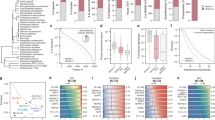Abstract
High-throughput methods for detecting protein interactions, such as mass spectrometry and yeast two-hybrid assays, continue to produce vast amounts of data that may be exploited to infer protein function and regulation. As this article went to press, the pool of all published interaction information on Saccharomyces cerevisiae was 15,143 interactions among 4,825 proteins, and power-law scaling supports an estimate of 20,000 specific protein interactions. To investigate the biases, overlaps, and complementarities among these data, we have carried out an analysis of two high-throughput mass spectrometry (HMS)–based protein interaction data sets from budding yeast, comparing them to each other and to other interaction data sets. Our analysis reveals 198 interactions among 222 proteins common to both data sets, many of which reflect large multiprotein complexes. It also indicates that a “spoke” model that directly pairs bait proteins with associated proteins is roughly threefold more accurate than a “matrix” model that connects all proteins. In addition, we identify a large, previously unsuspected nucleolar complex of 148 proteins, including 39 proteins of unknown function. Our results indicate that existing large-scale protein interaction data sets are nonsaturating and that integrating many different experimental data sets yields a clearer biological view than any single method alone.
This is a preview of subscription content, access via your institution
Access options
Subscribe to this journal
Receive 12 print issues and online access
$209.00 per year
only $17.42 per issue
Buy this article
- Purchase on Springer Link
- Instant access to full article PDF
Prices may be subject to local taxes which are calculated during checkout



Similar content being viewed by others
References
Fields, S. Proteomics. Proteomics in genomeland. Science 291, 1221–1224 (2001).
Pawson, T., Gish, G.D. & Nash, P. SH2 domains, interaction modules and cellular wiring. Trends Cell Biol. 11, 504–511 (2001).
Marcotte, E.M. et al. Detecting protein function and protein–protein interactions from genome sequences. Science 285, 751–753 (1999).
Gavin, A.C. et al. Functional organization of the yeast proteome by systematic analysis of protein complexes. Nature 415, 141–147 (2002).
Ho, Y. et al. Systematic identification of protein complexes in Saccharomyces cerevisiae by mass spectrometry. Nature 415, 180–183 (2002).
Pandey, A. & Mann, M. Proteomics to study genes and genomes. Nature 405, 837–846 (2000).
von Mering, C. et al. Comparative assessment of large-scale data sets of protein–protein interactions. Nature 417, 399–403 (2002).
Bader, G.D. et al. BIND—The biomolecular interaction network database. Nucleic Acids Res. 29, 242–245 (2001).
Ito, T. et al. A comprehensive two-hybrid analysis to explore the yeast protein interactome. Proc. Natl. Acad. Sci. USA 98, 4569–4574 (2001).
Uetz, P. et al. A comprehensive analysis of protein–protein interactions in Saccharomyces cerevisiae. Nature 403, 623–627 (2000).
Tong, A.H. et al. A combined experimental and computational strategy to define protein interaction networks for peptide recognition modules. Science 295, 321–324 (2002).
Drees, B.L. et al. A protein interaction map for cell polarity development. J. Cell Biol. 154, 549–571 (2001).
Fromont-Racine, M. et al. Genome-wide protein interaction screens reveal functional networks involving Sm-like proteins. Yeast 17, 95–110 (2000).
Ashburner, M. et al. Gene ontology: tool for the unification of biology. The Gene Ontology Consortium. Nat. Genet. 25, 25–29 (2000).
Mewes, H.W. et al. MIPS: a database for genomes and protein sequences. Nucleic Acids Res. 28, 37–40 (2000).
Costanzo, M.C. et al. YPD, PombePD and WormPD: model organism volumes of the BioKnowledge library, an integrated resource for protein information. Nucleic Acids Res. 29, 75–79 (2001).
Andersen, J.S. et al. Directed proteomic analysis of the human nucleolus. Curr. Biol. 12, 1–11 (2002).
Harnpicharnchai, P. et al. Composition and functional characterization of yeast 66S ribosome assembly intermediates. Mol. Cell 8, 505–515 (2001).
Schwikowski, B., Uetz, P. & Fields, S. A network of protein–protein interactions in yeast. Nat.Biotechnol. 18, 1257–1261 (2000).
Jeong, H., Tombor, B., Albert, R., Oltvai, Z.N. & Barabasi, A.L. The large-scale organization of metabolic networks. Nature 407, 651–654 (2000).
Jeong, H., Mason, S.P., Barabasi, A.L. & Oltvai, Z.N. Lethality and centrality in protein networks. Nature 411, 41–42 (2001).
Pruitt, K.D. & Maglott, D.R. RefSeq and LocusLink: NCBI gene-centered resources. Nucleic Acids Res. 29, 137–140 (2001).
Chervitz, S.A. et al. Using the Saccharomyces Genome Database (SGD) for analysis of protein similarities and structure. Nucleic Acids Res. 27, 74–78 (1999).
Norris, V. et al. Hypothesis: hyperstructures regulate bacterial structure and the cell cycle. Biochimie 81, 915–920 (1999).
Xenarios, I. et al. DIP, the Database of Interacting Proteins: a research tool for studying cellular networks of protein interactions. Nucleic Acids Res. 30, 303–305 (2002).
Ge, H., Liu, Z., Church, G.M. & Vidal, M. Correlation between transcriptome and interactome mapping data from Saccharomyces cerevisiae. Nat. Genet. 29, 482–486 (2001).
Olson, M.O., Dundr, M. & Szebeni, A. The nucleolus: an old factory with unexpected capabilities. Trends Cell Biol. 10, 189–196 (2000).
Visintin, R. & Amon, A. The nucleolus: the magician's hat for cell cycle tricks. Curr. Opin. Cell. Biol. 12, 752 (2000).
Acknowledgements
We thank Mike Tyers, Charlie Boone, and Tony Pawson for helpful discussions. This work was supported in part from grants from the Canadian Institutes of Health Research (CIHR), the Ontario Research and Development Challenge Fund and MDS-Sciex to C.H. G.D.B. is supported by an Ontario Graduate Scholarship (OGS).
Author information
Authors and Affiliations
Corresponding author
Rights and permissions
About this article
Cite this article
Bader, G., Hogue, C. Analyzing yeast protein–protein interaction data obtained from different sources. Nat Biotechnol 20, 991–997 (2002). https://doi.org/10.1038/nbt1002-991
Received:
Accepted:
Issue Date:
DOI: https://doi.org/10.1038/nbt1002-991
This article is cited by
-
FCA-based \(\theta\)-iceberg core decomposition in graphs
Journal of Ambient Intelligence and Humanized Computing (2024)
-
Mapping protein states and interactions across the tree of life with co-fractionation mass spectrometry
Nature Communications (2023)
-
Identifying protein complexes based on an edge weight algorithm and core-attachment structure
BMC Bioinformatics (2019)
-
Link clustering explains non-central and contextually essential genes in protein interaction networks
Scientific Reports (2019)
-
Predicting diabetes mellitus genes via protein-protein interaction and protein subcellular localization information
BMC Genomics (2016)



